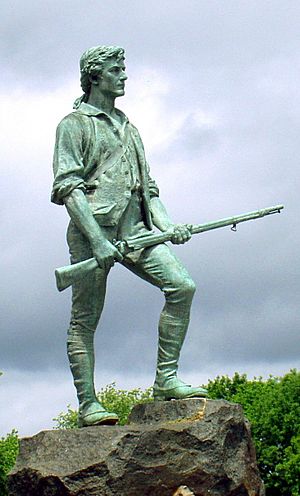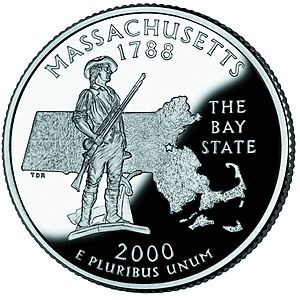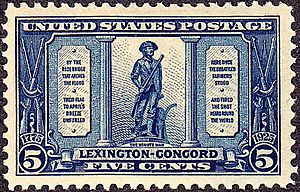Minutemen facts for kids

The Minutemen were special members of the militia in the American Colonies. They were called Minutemen because they could get ready for battle in just a minute's notice. Later, other US military groups were also called Minutemen to remember these brave original fighters.
Contents
History of the Minutemen

As early as 1645, some men in the Massachusetts Bay Colony were chosen from their town's "training bands." These men had to be ready to act very quickly.
The militia in Massachusetts had a long history of fighting. Every generation in New England knew about battles. Every town had a militia, and all men aged 16 to 60 were asked to join. Most of these men were farmers. They often fought alongside their cousins and family members.
Some towns in Massachusetts always had Minutemen units. Other towns kept their militia as one big group. After the Powder Alarm in 1774, Patriot leaders suggested that all militias should have "minute companies." These were special units that trained extra hard. They had to be ready to respond quickly to emergencies. Some towns followed this advice, but others did not.
Who Were the Minutemen?
Minutemen were usually 25 years old or younger. They were chosen because they were excited, trustworthy, and strong. They were often the first armed militia to arrive at a battle. Their officers were chosen by a vote. Each unit wrote a formal agreement that members signed when they joined.
They usually trained four times a year during peacetime. It was common for officers to talk with their men to make decisions. This happened even in the middle of a battle. They did not just give orders without discussion.
Minutemen at Lexington and Concord
Many stories about the Battles of Lexington and Concord in 1775 call all American fighters "Minutemen." This was the first battle of the American Revolutionary War. However, at that time, the Lexington Militia was one large unit. It was still called a "town training band."
Other colonies also formed similar "minute companies." Over time, "Minutemen" became a general term. It was used for any American militia member.
Why Minutemen Fought
The people of New England had a lot of experience with self-rule. They made many local decisions in town meetings. They also had their own colonial legislatures.
Most Minutemen could not explain big ideas about human rights. But they knew the British Army was now in their land. This army had once fought with them against common enemies. Now, it was there to take something important away. One man in Massachusetts said, "An Englishman's home is his castle." He barricaded his door to fight the British. This happened during the Battle of Lexington and Concord.
Even at the start of the war, many American Patriots fought for a political idea. They wanted to protect their way of life. Independence from Britain was not yet a common goal for everyone.
Equipment, Training, and Tactics

Most Colonial militia units did not get weapons or uniforms. So, they had to equip themselves. Many wore their own farming or work clothes. Some wore buckskin hunting outfits. A few added Native American-style touches to scare the enemy. This even included war-paint.
Most Minutemen used hunting rifles. These rifles did not have bayonets. But they were very accurate over long distances.
Fighting Style and Skills
The Continental Army regulars later received European-style military training. But the militias did not get much of this. Instead of fighting in straight lines, they were better as irregulars. They were good as skirmishers and sharpshooters.
Their experience helped them with irregular warfare. Most were skilled at frontier hunting. The American Indian Wars and the recent French and Indian War taught them about this fighting style. Many British troops from Europe were less familiar with it. The wild land near colonial towns was perfect for this type of combat. Minutemen knew this land very well.
The rifled-musket they used was also good for this role. The "rifling" inside the barrel made the rifle more accurate. It also gave it a much greater range than a smoothbore musket. However, rifles took longer to load. Because they fired slower, regular soldiers did not use them. But they were great for hunting.
As skirmishers, Minutemen could fire and then hide. They could get behind cover or other troops before the British could shoot back. The rifle's range and accuracy, plus their hunting skills, made Minutemen sharpshooters very dangerous.
Hiding Supplies
Ammunition and supplies were hard to get. British patrols often seized them. So, Minutemen often hid these items. They would leave them in fields or wooded areas. They also hid things under floorboards in houses and barns.
Legacy of the Minutemen
In 1875, a famous statue called the Concord Minuteman was created. This was to celebrate 100 years since the first armed resistance against the British. Daniel Chester French made this statue. It is one of his most famous works.
On the statue's base are words from Ralph Waldo Emerson's 1837 Concord Hymn. These famous words are, "Shot heard 'round the world." People traditionally believe the statue looks like Isaac Davis. He was the Captain of the Acton Militia. He was the first person killed in Concord during the 1775 battle.



